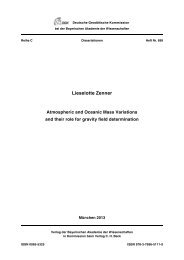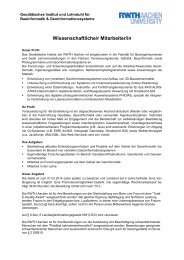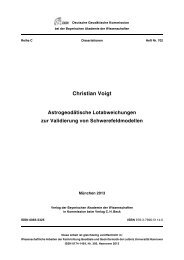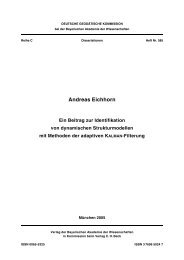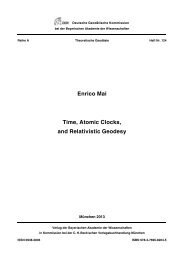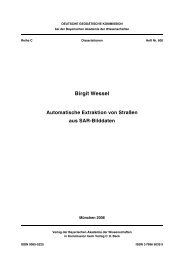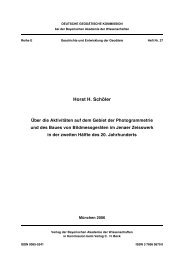v bundesamt für kartographie und geodäsie - DGK - Bayerische ...
v bundesamt für kartographie und geodäsie - DGK - Bayerische ...
v bundesamt für kartographie und geodäsie - DGK - Bayerische ...
Erfolgreiche ePaper selbst erstellen
Machen Sie aus Ihren PDF Publikationen ein blätterbares Flipbook mit unserer einzigartigen Google optimierten e-Paper Software.
Institute of Geodesy and Navigation – University of the Federal Armed Forces Munich 275<br />
2.1.7 HIGAPS<br />
Satellite-based navigation and positioning has already and<br />
will have an ever increasing influence on our daily life in<br />
the future. The trend converges in the U.S. Federal Communications<br />
Commission’s E-911 mandate that requires network<br />
carriers to provide location or geo-coding of<br />
emergency callers who are using wireless handsets. Similar<br />
activities of the European Commission <strong>und</strong>er the E-112<br />
initiative have led to a regulatory directive published in July<br />
2003. On the other hand, the increasing demand for<br />
commercial location-based services (LBS) has driven<br />
cellular phone and network manufacturers to focus on<br />
positioning solutions that are even more accurate than the<br />
regulatory mandates.<br />
Taken all this into account, an important step into the market<br />
for Galileo is the in-time availability of large-scale integrated<br />
combined Galileo/GPS receiver chipsets for consumer<br />
applications. This is the main idea behind the<br />
HIGAPS project – the development of a large-scale integrated<br />
combined Galileo/GPS receiver chipsets for consumer<br />
applications, preferably for pedestrian and vehicular<br />
users. The HIGAPS project is a national f<strong>und</strong>ed project,<br />
commonly f<strong>und</strong>ed by the Bavarian Ministry of Economic,<br />
Transport, Infrastructure and Technology and the German<br />
Space Agency DLR. The consortium is led by IfEN GmbH<br />
and consists of Infineon Technologies AG in Munich, the<br />
Fraunhofer Institute of Integrated Circuits in Erlangen, the<br />
Institute of Geodesy and Navigation of the University FAF<br />
Munich and the Department of Technical Electronics of the<br />
University Erlangen-Nuremberg.<br />
The Institute of Geodesy and Navigation focuses on the<br />
development of high sensitivity GPS/Galileo acquisition<br />
and tracking algorithms and on the development of navigation<br />
algorithms optimized for operation in an urban or indoor<br />
environment. GNSS navigation signals in these<br />
environments can be strongly attenuated (about 25 dB), or<br />
even blocked and are show intensive multipath effects. The<br />
algorithms cope with these problems and are developed and<br />
tested using the Institute of Geodesy and Navigation PCbased<br />
experiment Software Receiver ipexSR.<br />
2.2 Development of airborne gravimetry including<br />
GNSS satellite observations<br />
The detailed structure of the Earth’s gravity field and its<br />
temporal variations is important for many scientific and<br />
economic applications (e.g. geoid determination, geophysics,<br />
exploration purposes). In order to guarantee this<br />
wide field of use a measurement system for the determination<br />
of this gravity data on the one hand should be accurate,<br />
reliable and with a high resolution but an the other hand<br />
also efficient and independent of the area of operation. In<br />
comparison and in extension to satellite based and terrestrial<br />
methods airborne gravimetry seems to be an optimal<br />
solution to determine regional gravity variations. But current<br />
airborne systems cannot meet the requirements of the most<br />
users in accuracy and resolution caused by sensor errors.<br />
Therefore in the scope of the project an airborne vector<br />
gravimetry systems is in development using an existing<br />
strapdown INS (Sagem Sigma 30) and precise GNSS<br />
observations. The system errors influencing the gravity<br />
anomalies should be reduced to achieve an accuracy of 1<br />
mGal with an resolution of 1 km.<br />
In order to reach this goal some investigations are carried<br />
out concerning three different aspects: processing of INS<br />
data with suitable alignment algorithms and precise modelling<br />
of INS internal error sources, derivation of kinematic<br />
accelerations using GNSS observations (inclusion of new<br />
digital filters, differentiation methods, computation of<br />
acceleration using also multi-antenna receivers) and the<br />
determination of the gravity anomalies (possible smoothing<br />
filters, calibration models using additional information like<br />
gro<strong>und</strong> control points). As in 2002 the theoretical backgro<strong>und</strong>,<br />
the implementation of possible data processing<br />
methods and the development of the integrated sensor<br />
system were in the centre of interest in 2003 and 2004 its<br />
performance will be tested and evaluated in some practical<br />
flight experiments also in comparison to other implementations<br />
of airborne gravimetry systems.<br />
These investigations are carried out within the scope of a<br />
common research and development program of the German<br />
federal ministry of education and research and the DFG<br />
(Deutsche Forschungsgemeinschaft) called “Geotechnologien”.<br />
The project described above is one part of the key<br />
aspect “Investigation of the systems earth using (satellite<br />
based) remote sensing methods”.<br />
2.3 Integration of GNSS and INS measurements using<br />
the tight coupling principle<br />
In order to guarantee the user requirements in accuracy,<br />
reliability and also integrity in a lot of applications integrated<br />
GNSS/INS-system are used. Especially for navigation<br />
purposes in most cases only the combination with lowcost<br />
inertial measurement units with fiber-optic gyros or<br />
MEMS-technology sensors are required to effect a sufficient<br />
system performance, because its systematic errors can be<br />
estimated using the technique of Kalman filtering. In<br />
opposite to standard coupling implementations during this<br />
project the tracking loops of a GNSS receiver should be<br />
directly supported by inertial data (tight coupling). If the<br />
receiver dynamics measured by the INS can be subtracted<br />
from the satellite signal a decreased filter bandwidth allow<br />
an increased receiver performance especially in an high<br />
dynamic environment.<br />
On the one hand an tight-coupling simulation tool was<br />
implemented in order to evaluate mainly the required<br />
performance of inertial data and possible feed-back effects.<br />
On the other hand a practical test system for land navigation<br />
was developed realising this coupling principle. Thereby<br />
the signal processing of a GNSS receiver development tool<br />
was modified in such a way, that calculated pseudorange<br />
velocities and accelerations can be transferred directly into<br />
the receiver tracking loops. A significant reduction of<br />
satellite reacquisition time and a clear increase in tracking<br />
loop stability could be verified.




